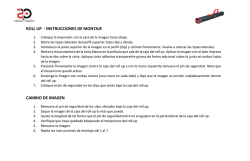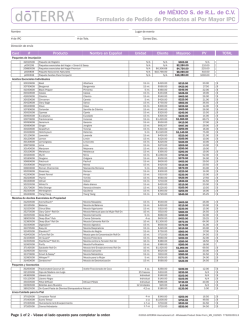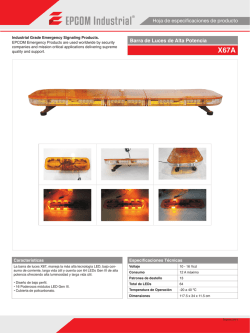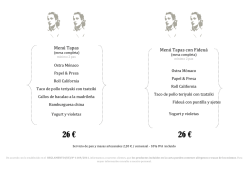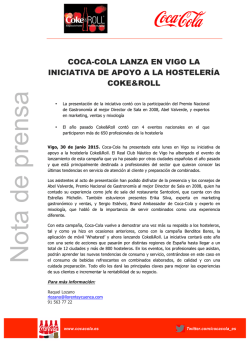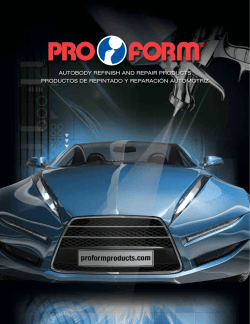
LINKFLOOR ROLL CONTRACT
INSTRUCCIONES DE INSTALACIÓN LINKFLOOR ROLL CONTRACT Los productos Linkfloor se presentan en rollo, con 2000 mm de anchura. Su uso es apropiado tanto para uso interior como exterior. Es un tejido vinílico montado sobre PVC con interior de poliéster, fibra de vidrio y un diseño y textura únicos. Totalmente impermeable, anti-bacterias, resistente a la luz y de fácil mantenimiento. REQUISITOS DE LA BASE Se deben tomar en cuenta los siguientes aspectos dependiendo del material del suelo donde se instala: 1. Hormigón: Se seguirá el sistema estándar. Si las condiciones de humedad del sustrato no están dentro de los estándares, se debe tratar con un sistema de control con base epoxy de altas prestaciones en ambientes húmedos y esperar hasta que esté completamente seco. 2. Madera: Se seguirá el sistema estándar. No instalar nuestros productos directamente sobre madera contrachapada, madera tratada u otros sustratos de madera irregulares. Es aconsejable siempre seguir la dirección de la parte más larga de la habitación. Esto mejorará la apariencia del suelo y hará más fácil su mantenimiento. Recuerda evitar el exceso de juntas. Instrucciones: 1. Dibujar una línea de 196 cm desde la pared. 2. Aplicar el pegamento en toda la superficie del rollo excepto en los 15 cm de margen desde la línea. 3. Dejar airear el pegamento. 4. Aplicar el pavimento siguiendo la línea. 5. Presionar para eliminar las posibles burbujas que hayan aparecido. 6. Repetir el procedimiento para el siguiente rollo, de forma que se solapen unos 4 cm aproximadamente. 7. Cortar en el centro de la zona solapada, a lo largo de la unión de los 2 rollos. Asegurarse siempre de que la superficie está limpia, completamente seca, plana y sin grietas. Si hay suciedad, ésta afectará al adhesivo y además, pueden calcarse los defectos en la superficie una vez colocado el producto. 8. Retirar las 2 tiras de merma. ADHESIVOS Y SELLADORES 9. Soldadura en frio: Consultar con el fabricante de estas colas. Para conseguir mejores resultados debe usar el pegamento adecuado para las diferentes áreas de instalación y seguir las instrucciones del proveedor. A continuación detallamos una guía simple de cómo elegir el pegamento adecuado: Sellado de Uniones - Tráfico bajo a moderado: Elige un pegamento acrílico de alta calidad como Henkel K188E, Mapei, ECO350 (Rollos), Mapei Ultrabone ECO800 (Losetas) o similares. - Tráfico alto: Utiliza pegamentos compuestos de poliuretano, como Henkel R710, o similar. * NOTA, para diseños rallados ajustar la zona solapada hasta que se ajuste el diseño. Aplicar la cola recomendada en el pavimento base y en el reverso de la pieza. Encolar el material en la posición adecuada para obtener una unión perfecta. Colocar la cinta adhesiva (precinto o cinta de pintor) centrado en la unión y presionarlo con un rodillo. Cortar la cinta adhesiva con un cuter y aplicar la cola recomendada dentro del corte para sellar las uniones. Retirar la cinta una vez la cola este seca. - Zonas húmedas: Usar pegamento especial resistente al agua, dependiendo del material del subsuelo. Para sellar un suelo de interior con altos niveles de tráfico (hoteles, restaurantes, tiendas, oficinas...) que requieren productos de alta resistencia a la suciedad y mucha durabilidad recomendamos compuestos de poliuretano como Pro-Coat o similar. Se recomienda sellador en frio para instalación de rollo y para las juntas, tipo Muller- Gmbh o similar. Al fijar el suelo a las escaleras se requiere un molde de protección para el borde frontal de cada escalón. SISTEMAS DE CALEFACCIÓN RADIANTE Cuando se realicen instalaciones sobre calefacción radiante, la temperatura no debe ser más de 29ºC. Coloca el pavimento al menos 7 días después de que se haya completado la instalación del sistema de calefacción. La Resistencia térmica es de 0,060Kxm2/W. INSTALACIÓN Recomendamos que sea instalado por un instalador de alfombras y moquetas profesional. Antes de la instalación, se aconseja dibujar un borrador del plan de colocación y seguir siempre la dirección longitudinal para evitar demasiadas juntas. Asegúrese de que el producto se coloca en sentido correcto (preste atención a la flecha marcada en la parte trasera). Nuestro material debe ser instalado en una superficie limpia y seca. La instalación se debe hacer a una temperatura de nos menos de 15ºC ACABADO FINAL Debe asegurarse de que todas las piezas forman parte de la misma colección y el mismo lote antes de ser instaladas. Es un tejido vinílico por lo que posee textiles y puede sufrir variaciones o cambios con el tiempo que quizás afecten al color. Usar un trapo blanco y limpio para eliminar pelusa y residuos. Usar un jabón neutro para la limpieza diaria/ seminal. Para limpieza a fondo usar vaporeta y proteger el material en caso de trabajos posteriores. INSTALACIÓN DEL ROLLO Para restauración a fondo tras un largo período de uso, se recomienda el uso del limpiador Syntilor. El rollo tiene una anchura aproximada de 2000 mm con algo de material extra que permite su superposición para ser instalado correctamente. ED1_RMO_04/07/15 LINKFLOOR ROLL CONTRACT_1 INSTALLATION GUIDE LINKFLOOR ROLL CONTRACT Linkfloor Roll products are presented in roll-packed (2000mm wide) . Products are suitable for indoor and outdoor uses. LInkfloor is made with vinyl material backed with PVC with a Polyester and Glass fibber core with a unique design and texture. Totally waterproof, anti-bacterial, color-fastness resistant to light and very easy maintenance. the appearance of the flooring and simplify the maintenance. Remember to avoid seams across the flooring. REQUIREMENT OF BASE CONDITION 2. Spread the adhesive out evenly and stop 15cm away from the line. Note the following requirements depending on the different surface material: 3. Allow the adhesive to aerate. 4. Lay out the flooring and follow the line’s outer edge. 1. Concrete: Standard practice shall be followed. If the moisture condition of substrate is not reaching the standards, please treat the substrate with heavy-duty epoxy-based moisture control system and wait until is completely dry. 5. Smooth out any bubbles so that the flooring is even. 2. Wood: Standard practice shall be followed. Please do not install our flooring products directly over plywood, treated wood or other uneven or unstable wood substrates. Always make sure the surface is clean, completely dry, flat and free of cracks. Dirt on the surface will affect the performance of adhesive and may telegraph to the surface once installed. ADHESIVES AND SEALER To reach a better adhesive result, please choose proper glue for different using areas and always follow user guides from the supplier. Here is a simple guide of how to choose the glue for: -Low to moderate levels of traffic: chose an acrylic high quality glue such as Henkel K188E, Mapei ECO350, Mapei Ultrabone ECO800 or similar. -High levels of traffic: Use polyurethane compound glues, such as Henkel R710, or similar. Instructions 1. Draw a line 196cm away from the wall. 6. Repeat the procedure with the next roll (steps 1 to 5) so that the roll overlaps by approximately 4 cm. 7. Cut through both lengths in the direction of the seam 8. Remove the surplus pieces *NOTE For a Stripe design to adjust overlap until the design meets. Then repeat double cut process 9. Cold welded sealing: Use recommended cold weld sealing products or similar system to achieve the best condition of the joint seam. Sealed Seams. Lift up both sides of the joint and apply recommended glue on the base subfloor. Glue down the material to achieve a perfect joint. Place special masking tape centered over the closely cut seam and press tightly with a roll. Cut masking tape with a rolling knife in the area of the seam. Apply the recommended glue inside of the seam and pull along . Pull off masking tape once dried. -Humid and wet areas: Use a water-resistant adhesive depending on subfloor material. To seal an indoor floor with high levels of traffic - hotel, food service areas, retail stores and offices that require higher dirt-resistant and long-lasting products, we strongly recommend polyurethane compound such as ProCoat or similar. Cold welded sealer is recommended for roll installations; all the joints must be sealed with a cold welded sealer such as Werner-Muller-Gmbh type, or similar. When fixing the flooring to the stairs, a protection mould is required for the front edge of each stair. UNDERFLOOR HEAT SYSTEM When installed on floors with under floor heat system, the temperature of surface cannot be higher than 29ºC. Install your floor at least 7 days after the installation of under floor heat system is completed. Thermal resistance 0,060Kxm2/W. INSTALLATION We highly recommend Linkfloor Roll to be installed by a professional carpet fitter. Before installation, we recommend to draw a draft of laying plan and always follow the lengthwise direction to avoid too many joints seams. Make sure our products lay in the same sense (refer to the arrow sign marked on the back side of our products). Our products are laid by gluing onto any dry and clean surface. The installation process must be done at a temperature no lower than 15ºC. FINAL FINISH Please, make sure all the flooring products are from the same item collection and made from the same lot. The product range is a vinyl textile therefore it has all the textile properties and these may suffer variations or changes with time. These variations may affect and alter the color. Use a white and damp clean cloth to wipe the surface of floor. Use Active when needed. Vacuum clean the whole area to make sure the cleanliness. We recommend covering the whole area for next job operation. ROLL INSTALLATION For intensive cleaning or long period renovation, we recommend use of Syntilor Composite Cleaner. Roll-packed products are finished in approx. 200cm width with some extra material allowing overlapping for proper installation. Always rolled out in the direction of length of the room - this will improve ED1_RMO_04/07/15 LINKFLOOR ROLL CONTRACT_1
© Copyright 2025
